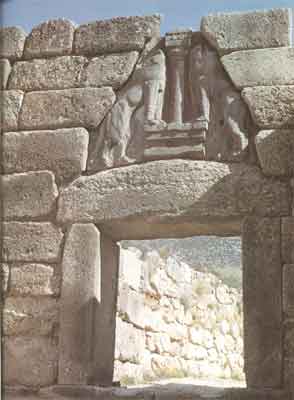The Lion Gate is the name given to the main entrance to the citadel of Mycenae after of the sculpture that sits above it. The gate was excavated and restored by the Greek archaeologist Kyriakos Pittakis, the first to excavate Mycenae in 1841. The actual sculpture is of two lions separated by a single column and stands about three feet high. The heads of the lions are now missing, indicating that they were originally made of metal but for some reason or another are no longer around today.
The gate represents a combination of Cyclopean construction and ashlar masonry. Cyclopean construction is a form of megalithic architecture, or building with very large stones. Ashlar masonry is simply an organized way of laying out square/rectangular cut stones in a regular manner. The opening for the gate is about ten feet by ten feet and utilizes a post and lintel system, where a single stone crosses over the doorway supported by stones on either side. Above the lintel is an area called the “relieving triangle” because it is typically filled with a lighter stone or some other material to take pressure off of the lintel. It is in this area that the actual carving of the lions sits even though it still weighs nearly two tons.
A stepped ramp goes up through the gate and it is protected by a postern on the right from which defenders of the city could hit the non-shielded right side of any attackers. After entering the citadel Grave Circle A is located on the right and the megaron of Mycenae located ahead. Some other entrances into the city also exist, such as the Postern Gate, but compared to the Lion Gate these are minor.

The Lion Gate at Mycenae
Works Cited:
Biers, William R. The Archaeology of Greece. Ithaca: Cornell University Press, 1996.
Whitley, James. The Archaeology of Ancient Greece. Cambridge: Cambridge University Press, 2001.
--Mike Bohl
Posted at Dec 13/2007 05:08PM:
chris witmore: Great job Mike. I once did a little new media project on the Lion Gate called One Hour at Mycenae. You might find it of interest.
Posted at Dec 13/2007 11:41PM:
Harry Anastopulos: This is one of the few things I can recall from my 8th grade Greece history class. It's a shame that the heads are now gone. If they were of a precious metal, I'm sure robbers have long run away with them or they might have been melted down in antiquity...this really brings out the fact that what we see in archaeology is by nature fragmentary, of course opening the door for much creativity in our reconstruction of the past.
